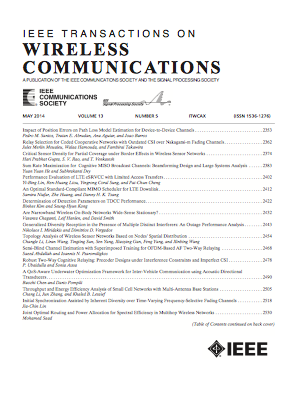学习波束形成码本与可重构智能表面的主动传感
IF 10.7
1区 计算机科学
Q1 ENGINEERING, ELECTRICAL & ELECTRONIC
引用次数: 0
摘要
本文探讨了一种主动感知方案中基站(BS)和可重构智能面(RISs)的波束形成码本设计,移动用户通过在RISs上的反射向基站发送一系列导频信号,并依次从各自的码本中仔细选择BS波束形成码字和RIS码字,自适应配置基站和RISs波束形成码本,逐步聚焦于用户。大多数现有的RIS码本设计都不是为主动感知量身定制的,这意味着下一个码字的选择应该取决于迄今为止所做的测量,并且码字的顺序应该动态地聚焦对用户的反射。此外,现有的码字选择方法大多依靠波束训练中的穷举搜索来识别信噪比(SNR)最高的码字,因此随着码本规模的扩大,会产生大量的导频开销。本文提出了一种基于学习的码本构建和主动感知码字选择方法。所提出的学习方法旨在通过从各自的码本中递归地选择一系列BS波束形成码字和RIS码字来定位服务区域内的目标,而无需进行详尽的波束训练。码本设计和码字选择融合了矢量量化变分自编码器(VQ-VAE)和长短期记忆(LSTM)网络的关键思想,分别学习码本的离散函数空间和测量之间的时间依赖性。本文章由计算机程序翻译,如有差异,请以英文原文为准。
Learning Beamforming Codebooks for Active Sensing With Reconfigurable Intelligent Surface
This paper explores the design of beamforming codebooks for the base station (BS) and for the reconfigurable intelligent surfaces (RISs) in an active sensing scheme for uplink localization, in which the mobile user transmits a sequence of pilots to the BS through reflection at the RISs, and the BS and the RISs are adaptively configured by carefully choosing BS beamforming codeword and RIS codewords from their respective codebooks in a sequential manner to progressively focus onto the user. Most existing codebook designs for RIS are not tailored for active sensing, by which we mean the choice of the next codeword should depend on the measurements made so far, and the sequence of codewords should dynamically focus reflection toward the user. Moreover, most existing codeword selection methods rely on exhaustive search in beam training to identify the codeword with the highest signal-to-noise ratio (SNR), thus incurring substantial pilot overhead as the size of the codebook scales. This paper proposes a learning-based approach for codebook construction and for codeword selection for active sensing. The proposed learning approach aims to locate a target in the service area by recursively selecting a sequence of BS beamforming codewords and RIS codewords from the respective codebooks as more measurements become available without exhaustive beam training. The codebook design and the codeword selection fuse key ideas from the vector quantized variational autoencoder (VQ-VAE) and the long short-term memory (LSTM) network to learn respectively the discrete function space of the codebook and the temporal dependencies between measurements.
求助全文
通过发布文献求助,成功后即可免费获取论文全文。
去求助
来源期刊
CiteScore
18.60
自引率
10.60%
发文量
708
审稿时长
5.6 months
期刊介绍:
The IEEE Transactions on Wireless Communications is a prestigious publication that showcases cutting-edge advancements in wireless communications. It welcomes both theoretical and practical contributions in various areas. The scope of the Transactions encompasses a wide range of topics, including modulation and coding, detection and estimation, propagation and channel characterization, and diversity techniques. The journal also emphasizes the physical and link layer communication aspects of network architectures and protocols.
The journal is open to papers on specific topics or non-traditional topics related to specific application areas. This includes simulation tools and methodologies, orthogonal frequency division multiplexing, MIMO systems, and wireless over optical technologies.
Overall, the IEEE Transactions on Wireless Communications serves as a platform for high-quality manuscripts that push the boundaries of wireless communications and contribute to advancements in the field.

 求助内容:
求助内容: 应助结果提醒方式:
应助结果提醒方式:


